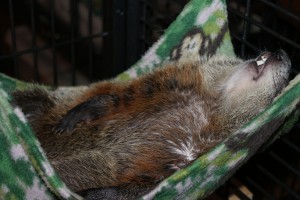The Nuts and Bolts of Hibernation
by Ed Grabianowski
Hibernation is mainly controlled by the endocrine system. Glands in the body alter the amounts of hormones being released and can control just about every physiological aspect of hibernation.
- Thyroid – gland that controls metabolism and activity levels
- Melatonin – hormone that controls the growth of winter coats
- Pituitary – gland that controls fat build up, heart rate and breathing rate, as well as metabolic functions
- Insulin – hormone that regulates the amount of glucose (sugar) needed by the animal
When a mammal enters hibernation, it becomes somewhat like a cold-blooded animal. Its body temperature will vary depending on the temperature around it. However, there is a minimum temperature, known as a set point. It’s just like setting the temperature on your thermostat at home. When the mammal’s body temperature reaches the set point, the metabolism kicks in and burns some fat reserves. This generates some energy, which is in turn used to heat things back up above the set point. Larger animals have a higher set point. If they let their temperature drop too low, it would require an enormous amount of energy to heat back up again.
Several other things occur when an animal is hibernating:
- Heart rate drops to as little as 2.5 percent of its usual level. A chipmunk’s heart rate slows to five beats per minute from the usual 200.
- Breathing rate drops by 50 percent to 100 percent. Yes, 100 percent. Some animals stop breathing entirely. A few reptiles go their entire hibernation period without breathing, and even mammals have shown the ability to survive with drastically reduced oxygen supplies.
- Consciousness is greatly diminished. This varies by species, but many hibernating animals are completely oblivious to their surroundings and are nearly impossible to wake up. If you were to wake up a hibernating animal midwinter, you would be effectively killing it. It would use up so much energy warming itself up in order to awaken that it would have no chance of making it to spring even if it could re-enter hibernation.
Body fat, which is packed with energy, is burned off to provide the energy necessary to maintain these minimal levels of body functions. This can be very efficient — Arctic ground squirrels live entirely off of stored body fat for as long as nine months. Some species are unable to store enough body fat, so those animals have a lighter hibernation, allowing them to awaken periodically for a snack.
If an animal is burning fat or snacking on stored nuts all winter, what happens to all the waste? No fecal matter is produced because nothing is passing through the digestive tract and intestines. But the body is always producing urea, the waste product that is the main component of urine. Hibernating animals’ bodies are able to recycle the urea. Bears don’t urinate all winter, but they break the urea down into amino acids. Even though they don’t drink, they don’t get dehydrated either. They’re able to extract enough water from their own body fat to stay hydrated.


